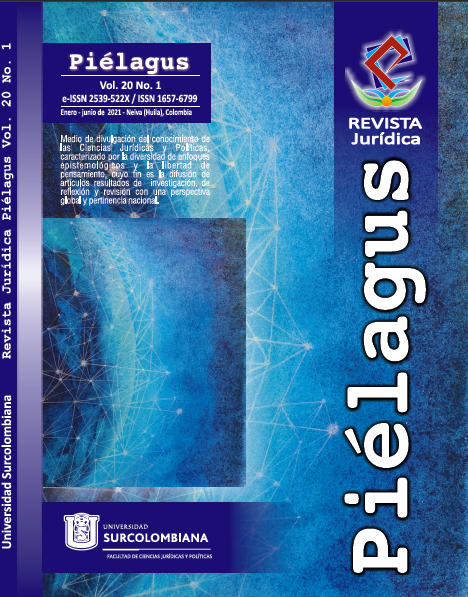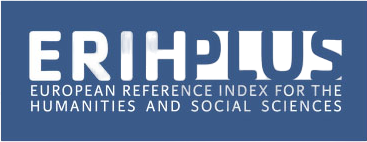El impacto de las audiencias virtuales en el debido proceso
##plugins.themes.bootstrap3.article.main##
Partiendo de una breve reseña del estado de situación de los sistemas judiciales en el contexto de la pandemia de la Covid 19, se analiza el impacto de la utilización masiva de la videoconferencia en el proceso penal. Se destaca la experiencia en los países anglosajones sobre el uso de la telepresencia y se abordan algunas posiciones jurisprudenciales relevantes sobre la constitucionalidad de las audiencias virtuales. Se exponen las ventajas y desventajas de la utilización de la videotecnología apuntadas por la escasa investigación empirica existente, y se analiza la posible afectación de las garantías judiciales mínimas de los acusados.
Descargas
##plugins.themes.bootstrap3.article.details##
I. Albornoz-Barrientos, J., y Magdic, M. (2013). Marco jurídico de la utilización de videoconferencia en materia penal. Revista Chilena de Derecho y Tecnología Centro de Estudios en Derecho Informático, 2(1), 229-260. https://doi.org/10.5354/0719-2584.2013.27012
II. Arellano J., Cora, L., García, C., y Sucunza, M., (2020). “Estado de la Justicia en América Latina bajo el COVID-19”. Centro de Estudios de Justicia de las Américas (CEJA). http://scm.oas.org/pdfs/2020/CP42372TCEJACOVID19.pdf
III. Balcázar, M. A. (2020). “Situación de la provincia de Tucumán. La crisis como oportunidad en el servicio público de justicia”, en “Juicios orales en tiempo de pandemia”, Lorenzo, L., compilador, Ed. Editores del Sur.
IV. Baldé, C., Forti, V., Gray, V., Kuehr, R., Stegmann, P. (2017). Observatorio Mundial de los Residuos Electrónicos 2017, Cantidades, Flujos y Recursos. Universidad de Naciones Unidas, Unión Internacional de Telecomunicaciones y Asociación Internacional de Residuos Sólidos, Bonn/Ginebra/Viena. https://www.itu.int/en/ITU-D/Climate-Change/Documents/GEM%202017/GEM%202017-S.pdf
V. Bureau of Justice Assistance (BJA). (2000). U.S. Department of Justice. https://university.pretrial.org/viewdocument/survey-of-pretrial-s
VI. Campana, J. B. (2020). Situación de la provincia de Río Negro, en “Juicios orales en tiempo de pandemia”, Lorenzo, L., compilador, ed. Editores del Sur, 67-72.
VII. Chesterton, G. K. (2018). El hombre que fue jueves, una pesadilla. Ed. Feeditorial Publishing House. (Original publicado en 1908). https://freeditorial.com/es/books/el-hombre-que-fue-jueves/related-books
VIII. Convención Americana sobre Derechos Humanos (CADH). (1969, 22 de noviembre).
IX. Convenio Iberoamericano sobre el Uso de Videoconferencia en la Cooperación Internacional entre Sistemas de Justicia. (2010, 03 de diciembre). Conferencia de Ministros de Justicia de los Países Iberoamericanos (COMJIB).
X. Convenio para la Protección de los Derechos Humanos y de las Libertades Fundamentales (CPDHLF). (1951, 04 de noviembre).
XI. Corte Interamericana de Derechos Humanos (Corte IDH). (2003, 26 de noviembre). “Juan Humberto Sánchez vs. Honduras”, Caso 11.703, Sentencia, Serie C No. 102. (2004, 07 de setiembre), “Tibi vs. Ecuador”, Sentencia, Caso 12.124, Serie C No. 114.
XII. Corte Interamericana de Derechos Humanos (Corte IDH). (2020, 30 de junio). “Olivares Muñoz y otros vs. Venezuela”, Resolución de la Presidenta de la Corte, Visto 2, Considerando 2 a 6, 11 y 12.
XIII. Corte Suprema de Justicia de la Nación (CSJN). (2020). Acordadas N* 6, 8, 10, 11, 12, 13, 14, 15, 16 y 18. República Argentina.
XIV. Davis, R., Matelevich-Hoang, B. J., Barton, A., Debus-Sherrill, S., y Niedzwiecki, E. (2015). Research on Videoconferencing at Post- Arraignment Release Hearings, Phase I Final Report. ICF International, National Criminal Justice Reference Service. https://www.ncjrs.gov/pdffiles1/nij/grants/248902.pdf
XV. Del Río, V. (2020). Situación de la provincia del Chaco. Resistiendo a la Pandemia. en “Juicios orales en tiempos de pandemia”, Lorenzo, L., compilador, ed. Editores del Sur, 9-46.
XVI. Diamond, S. S., Bowman, L. E., Wong, M., y Patton, M. M. (2010). “Efficiency and Cost, The Impact of Videoconferenced Hearings on Bail Decisions”. Journal of Criminal Law & Criminology, 100 (3) (article 8), 869-902.
XVII. Duce, M. y Riego, C. (2007). Proceso Penal. Ed. Editorial Jurídica de Chile, Santiago de Chile.
XVIII. Feeley, M. M. (1992). The Process is the Punishment. 1st paperback ed., Ed. Russell Sage Foundation, New York.
XIX. Freedman, D. y Sandoval, L. (2016). El uso de las videoconferencias en el Consejo de la Magistratura de la Nación. Asociación de Docentes de la Facultad de Derecho de la Universidad de Buenos Aires, 675-678. http://www.derecho.uba.ar/docentes/libro-el-control-de-la-actividad-estatal-ii.php
XX. Gibbs, P. (2017). Defendants on video – conveyor belt justice or a revolution in access? ed. Transform Justice, London, UK. http://www.transformjustice.org.uk/wp-content/uploads/2017/10/Disconnected-Thumbnail-2.pdf
XXI. González-Postigo, L. (2020). Sobre la evaluación de credibilidad de los testigos y los juicios orales en formato virtual, en “Juicios orales en tiempo de pandemia”, Lorenzo, L., compilador, ed. Editores del Sur, 87-93.
XXII. Gourdet, C., Witwer, A. R., Langton, L., Banks, D., Planty, M. G., Woods, D., y Jackson, B. A. (2020). “Court Appearances in Criminal Proceedings Through Telepresence Identifying Research and Practice Needs to Preserve Fairness While Leveraging New Technology”, ed. RAND Corporation, Police Executive Research Forum, RTI International and University of Denver. https://doi.org/10.7249/RR3222
XXIII. Juliano, M. A. (2020). La pandemia y el péndulo, en “Juicios orales en tiempo de pandemia”, Lorenzo, L., compilador, ed. Editores del Sur, 95-101.
XXIV. Magna Charta. (1215). https://www.bl.uk/collection-items/magna-carta-1215
XXV. Mehrabian, A. (1971). “Silent Messages”. Ed. Wadsworth Publishing Company Inc., Belmont, California, USA
XXVI. National Center for State Courts (NCSC). (2010). NCSC Video Conferencing Survey. https://www.ncsc.org/__data/assets/image/0023/16682/q21-png.png
XXVII. Nowak, M. (1993). U.N. Covenant on Civil and Political Rights CCPR Commentary, ed. N. P. Engel Publisher, Arlington, USA.
XXVIII. Pacto Internacional de Derechos Civiles y Políticos (PIDCP). (1966, 19 de diciembre). Resolución N° 2.200 (XXI) de la Asamblea General de las Naciones Unidas.
XXIX. Pretrial Justice Institute (PJI). (2009). Survey of Pretrial Services Programs, Ed.
XXX. Rossner, M. y Tait, D. (2020). Courts are moving to video during coronavirus, but research shows it´s hard to get a fair trial remotely. The Conversation, 07/04/2020. https://theconversation.com/courts-are-moving-to-video-during-coronavirus-but-research-shows-its-hard-to-get-a-fair-trial-remotely-134386
XXXI. Schiavo, N. (2020). Juicios bajo plataforma virtual. Inmediación y derecho al recurso. En “Juicios orales en tiempo de pandemia”. Lorenzo, L., compilador, ed. Editores del Sur, 102-124.
XXXII. Senft, T. M. (2003). “Videoconferencing”, Britannica. https://www.britannica.com/technology/videoconferencing
XXXIII. Smith, J. (2013). Remote Testimony and Related Procedures Impacting a Criminal Defendant’s Confrontation Rights. Administration of Justice Bulletin No. 2013/02, February 2013, School of Government, University of North Carolina, 1-18.
XXXIV. Stefanuca, J. S. (2005). Crawford v. Washington, The Admissibility of Statements to Physicians and the Use of Closed-Circuit Television in Cases of Child Sexual Abuse. University of Maryland Law Journal of Race, Religion, Gender and Class, 5(2), 411-432. http://digitalcommons.law.umaryland.edu/rrgc/vol5/iss2/11
XXXV. Strauss, P. (2020). “Due Process”, Legal Information Institute, Cornell Law School. https://www.law.cornell.edu/wex/due_process
XXXVI. Suprema Corte de Justicia de Chile (SCJCH). (2020, 24 de agosto). Sentencia, Rol Nro. 94.279-2020. http://www.pensamientopenal.com.ar/system/files/2020/09/fallos49395.pdf
XXXVII. Supreme Court of the United States (SCUS). (1988, 29 de junio). “Coy v. Iowa”, (487 U.S. 1012, 1016–22 (1988)); (1990, 27 de junio), “Maryland v. Craig”, (497 U.S. 836 (1990)); (2004, 08 de marzo), “Crawford v. Washington”, (541 U.S. 36 (2004)).
XXXVIII. Trechsel, S. (2006). Human Rights in Criminal Proceedings. Ed. Oxford University Press, New York, USA. https://doi.org/10.1093/acprof:oso/9780199271207.001.0001
XXXIX. Tribunal Europeo de Derechos Humanos (TEDH): (2006, 02 de febrero): “Rippe v. Germany”, Application no. 5398/03; (2006, 05 de octubre): “Marcello Viola v. Italy”, Application no. 45106/04; (2007, 27 de noviembre): “Zagaria v. Italy”, Application no 58295/00; (2010, 02 de noviembre): “Sakhnovskiy v. Russia”, Application no. 21272/03.
XL. U.S. Constitution. (1776-1791). Amendments V and VI.
XLI. US Courts, Judicial Conference, Advisory Committee on Criminal Rules. (2002). Cape Elizabeth, Maine, september 26-27, 2002, Criminal Rules Under Consideration, A. Rules Pending Before Congress, Rule 26, Taking Testimony, Proposed Amendment Regarding Taking of Testimony by Remote Transmission, 1. Proposed Rule 26 (B), Rejected by Supreme Court. https://www.uscourts.gov/sites/default/files/fr_import/CR2002-09.pdf
XLII. Comité de Derechos Humanos (HRC). (2014, 23 de octubre). Observación general Nº 35, Artículo 9 “Libertad y seguridad personales”.
XLIII. Ontario Court of Justice. (2020, 11 de mayo). “Covid-19, Ontario Court of Justice Protocol Re Bail Hearings”. https://www.ontariocourts.ca/ocj/covid-19/covid-19-protocol-bail-hearings/

















